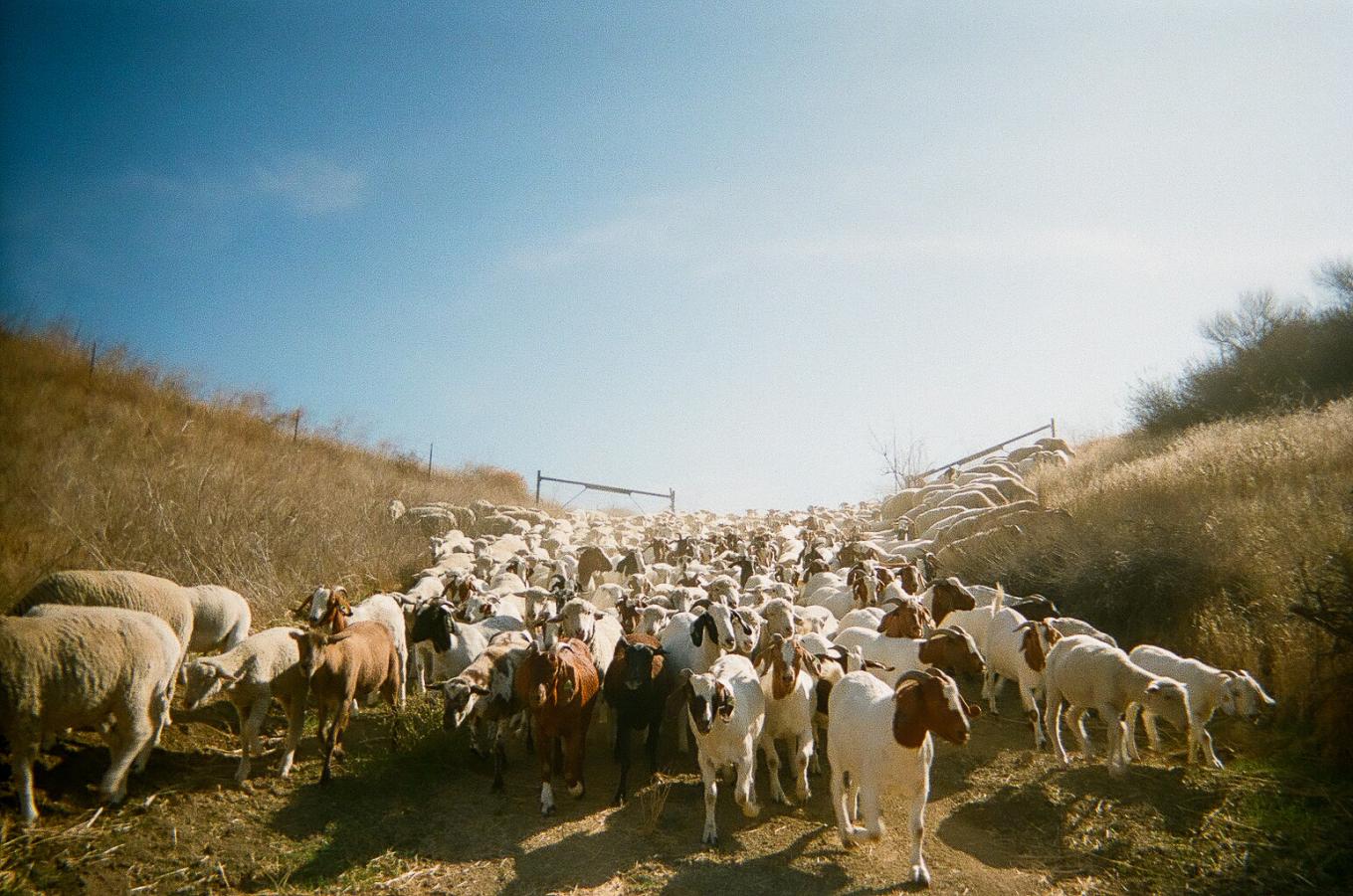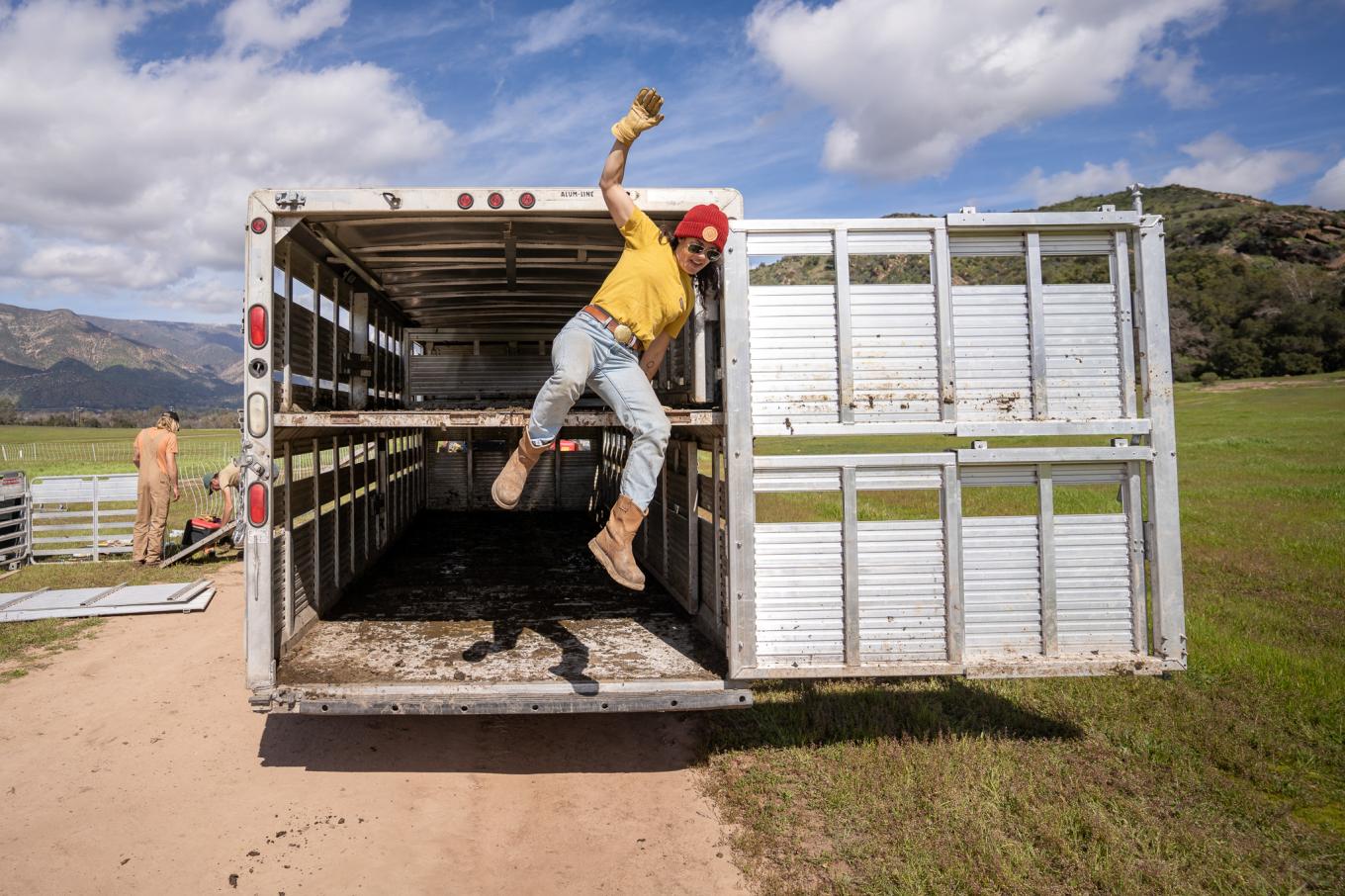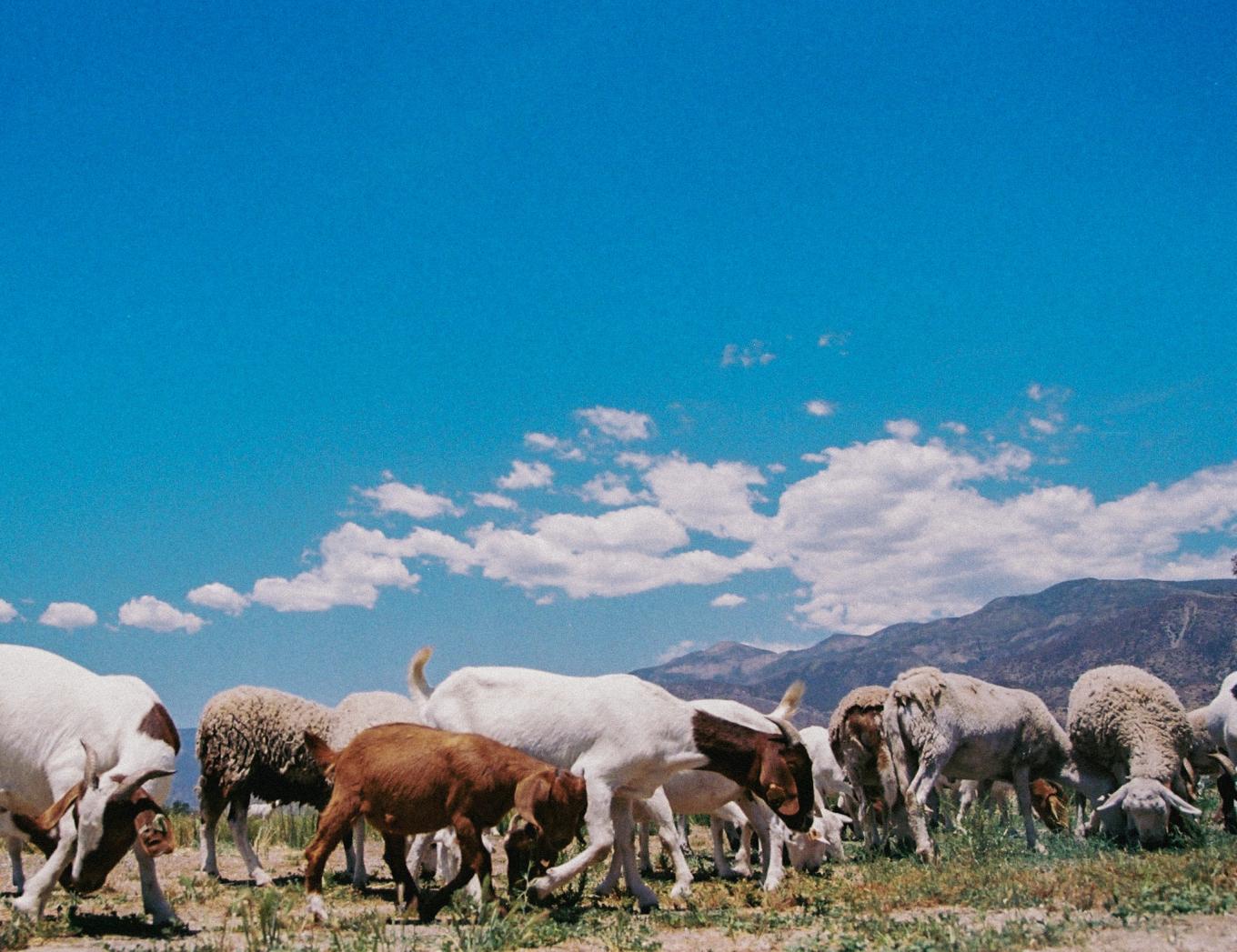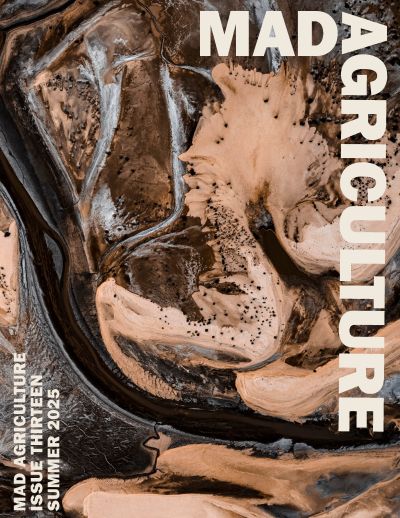
The Mad Agriculture Journal
Be Like a Sheep
Published on
August 06, 2025
Introduction by
Cole Bush
Essay by
Diane Anastasio
Photos by
Liam Pickhardt
Cole Bush
It’s 7:16am and the fourth text of the day reads, “one of the churro ewes (ear tag #4) is down laying alone. temp is 105.3, respiratory is fine. 104 BPM. What do you want me to do?” I’m at my laptop, working on my second cup of coffee, tapping away and squinting as I attempt to design the yarn labels for the wool festival that is in the afternoon. My eyes sting from yesterday’s long day at the screen topped off with dust kicked up from the ranch while walking my two new pack mules. I went to bed too late despite my every attempt to talk myself to sleep. I am like a fidgety five-year-old when it comes to bed time. I find every reason to stay up, often starting a new creative project that I typically only get 15 minutes into before I again tell myself, it’s time for bed, Cole. I only have a few hours before heading to the ranch. In fact, it’s only an hour and then I rush to be easeful while Kaitlyn and Echo, the ranch-tending shepherds, coax two very large ewes, once “bummer lambs” orphaned little lambs that we bottle fed three seasons ago. They are the best fed sheep that I own and in exchange for us training our herding dogs on them in the round pen, we spoil them rotten with collars and all. In addition to Kaitlyn’s sheep we are bringing Milton to the fiber festival. Milton is also a maturing “bummer lamb” who became my emotional support animal reared in our living room, kitchen, and occasionally the bedroom, for the first several years of his life. He came to me hours old, limp and cold. He was one of the lambs that made it and he was my pride and joy that kept my spirit alive like a dimmed candlelight in the darkest of winter days.
The year he was born was another record rain year yielding floods throughout the Ojai Valley—a typically dry and brittle landscape of chaparral, oak forests, citrus orchards and small hobby farms of the rich and famous—hadn’t been experienced for decades. Another historical climate event. Every year since I’ve had my prescribed grazing business there has been not one but two natural disasters—deeming our region a state of emergency almost as if the hardships come in a syncopated rhythm. I’m the leader of the shepherd pack and I have to hold it together. I may be the smallest in stature of the bunch but I am the one in front leading charge through the toughest times.

I often miss the beautiful, quiet moments, even though that’s the perk of the shepherd’s life that they certainly deserve. Today even though I am deemed, “the shepherdess”, I am more of a human-herder, a desk-jockey riding an imaginary donkey that doesn’t seem to move quickly enough to get where I need to be. I am chronically late and often the team knows that I will be exactly 15 minutes after I say I will be arriving. It should be in the welcome packet to the new shepherds but they learn quickly that I will arrive when I do with wireless earbuds on a call, typically a pretty important one, as I handle the most critical and foundational responsibilities of the business. I get deals done. This means countless meetings, proposals, site-visits on the larger potential contracts, and lots and lots of talking, texting, and emails. If it weren’t for my Tasmanian Devil business twirls on the daily we wouldn’t have the work to justify everyone’s jobs and the 550 head of sheep and goats that we deploy every year. TBD when we go off to work. We don’t know when the rains will start or end, which means we don’t know when the grass will grow, greening up for a limited time before the “green turns to gold”. The majority of the demand for our work, the time that we make the money, to hold us through the four to six months that we are not getting paid to work, is often a window of four months. That’s when the phone calls pop off, email inquiries pour into my inbox, and stops on the street for requests to come by to check out a property in town that needs some “fire fuels abatement” before the counties clearance deadline of June 1. It’s like having local fame primarily because folks know I “got goats. now for hire”.
I am 40 years old now and I still feel like a young agrarian. According to the average age of a farmer or rancher in America I certainly am. The growing creases and leathering of the skin on my face have seemed to be at an accelerated pace. And like water finds the paths of least resistance over barren, top soil-depleted landscapes, creating deeper dug streams and ravines every rain season, that’s how my aging process too has progressed. Every year the cuts and lines grow deeper with the seasonal rains that have not once been nice to me, the shepherds, or my animals. But we can’t hate the rain for it is life and it means that the grass will grow again, the paid work will begin to flow, and the parched air and earth of Summer and Fall will hydrate us even though the “cup runneth over” of the unrelentless amounts of rain.

It’s days past when I was supposed to deliver this written piece that I’ve spent countless hours drafting and crafting the themes, stories, and metaphors for, and yet it’s days before the journal goes to print and I’ve now decided to deliver an honest report: that what I’m able to write these days takes the form of long, sometimes non-linear exchanges—information sharing or responses, emails, texts, and rushed social media posts that I never edit until I might catch the many errors in grammar, punctuation (thank goodness for spellcheck, even though most of the time it’s still wrong). I can write for survival but can I write for creativity and wholehearted blooming expression of how this work of being an advocate, entrepreneur, and educator of prescribed grazing (now in the Public Resource Code of California after two years of advocating deeply alongside other graziers, land stewards, and government people), land and livestock- meaningful and impactful work has been the tagline of how I define the career of a grazier. And although I’ve shifted roles into another reality where I’ve become more of the Lorax of the sheep and shepherds, instead of the trees, I am frequently reminded of how “impactful and meaningful” my work is leading charge for the next-generation of graziers as “ecological doctors” tending to animals and the land for growing ecological resilience, public safety, and work that is ancient and globally significant today as it was from the beginning of domestication of animals.
The people who I work with, the people I’ve employed allowing them to have a job title that most likely is a fantastic conversation starter on a first date, the animals I’ve grown up with in the past 5 years who have become my family, my partner that I’ve seen transform into an enduring, skilled, thoughtful, committed “sheepman” who only five years ago was shepherding baristas at the cafe back home that was actually my first place of work when I was just about 16 - these individuals and animals, and the land that we tend year in and year out, remind me that the worn skin, bones, muscles have been earned with the highest esteem to operate with integrity, dedication, and resilience as I keep defining what it means every day as I meet the next issue after next. I have to leave the ranch now. It will be a glorious day sharing mutual love for wool, sheep, sharing with community, fiber arts, and yes, I most likely will find a soap box, a microphone, and do what I do best: sing and shout praises of the animals, people, and place that give us meaning, hope, and purpose. My inner compass and motto that I touch on in every interview, presentation, and podcast is“what drives me forward is supporting a “culture of care”. Animals make us better people, and let us not forget that we too are creatures requiring the same things as many others in the animal kingdom need.
Diane Anastasio, who authored the beautiful essay, Be Like a Sheep, is an important character in my stories these days. They provide me with comfort, care, light-hearted fun and the hope that my “emotional support donkeys” back at the ranch gift me regularly. I love donkeys, and to me, Diane is a spunky version of Eeyore, with me as their unbridled Tigger. Together we have woven quite the story as weirdo shepherds writing a story together on our own explorations in search and discovery for wellness, sanity, and space to create, play, and sleep as we have now entered our fourth, or is it fifth decade? Diane’s writing makes me cry every time I read their essays and prose. They nail it so accurately: the life of a shepherd in our context in Southern California formerly urbanite queerdos amongst many other things. Diane writes in metaphor of how we can learn from the sheep, the herd as one, our experiences working so closely and rawly tending to livestock in bizarre places in very unique contexts. They write about their journey which in many ways I feel is mine and collaborating with Diane has been a lifeline as we both are co-creating a life where we call ourselves shepherds, regardless if we are with the sheep and goats or not, for it is only us and the other graziers in the world who know the shepherd’s life, because if you know you know.
Cole Bush

Be Like a Sheep
It’s a dusty Saturday morning in the canyons of LA county with daytime temperatures climbing into the 110s. My fellow shepherds and I gather together to move a herd of 600 sheep and goats through thick chaparral to their new grazing area. We herd sheep across these rolling hills for a living, the brittle landscape crackling beneath our feet as we trample mustard and brush in preparation for fire season. The sheep travel in a mob, led ever forward by the scent of fresh feed, by the hope and promise of grasses not yet touched by their teeth and soil not yet grooved by their hooves. They move like a wave across the landscape, undulating in smooth currents, flowing together as one body like water over rocks, through dense vegetation, and amidst boulders that tower to the sky.
As prey animals, sheep seek the refuge of the herd, the intrinsic protection of a vast networked community. A single sheep is vulnerable, prickling at seemingly negligible changes in their immediate environment, ears always alert to predator activity nearby. But when enveloped in the herd, sheep are shielded from potential danger. I often hear the refrain that sheep lack intelligence, but really, they are just collectivists who operate within a shared methodology of the herd that prioritizes community care, safety and support for its members.

Moving the sheep just one mile occupies the entire morning. We move slowly and deliberately, observing the patterns of their body language, movements and curiosities. As shepherds, we sink into this corporeal language with the placement of our bodies in order to gently guide the herd across the landscape. Being in and with a herd requires a deep awareness of movement: how we move individually and in a group, how we impact each other when we move, how we shape a space and change the way it feels as we move. Moving like a herd is a form of communication that extends beyond the verbal, drawing messages from deep in our bones.
As I scan the shape of the herd cascading through these canyons, I reflect on our own capacity for community-building and mutual group entanglement. I teach country line dancing in Ventura and am a constant witness to the power that surfaces through collective movement, through moving like a herd. Line dancing requires us to adhere to specific patterns of steps in order to move together as one body in unison. Our understanding of a common movement language fosters a sense of safety while generating an unbridled euphoria made manifest in high kicks, sultry hips and hitches to the heavens. The dynamics of the sheep herd are so intimately present in the ways in which we line dancers follow each other, learn from each others’ bootsteps when choreography eludes us, in how we shape space as we flow like water across the landscape of the hardwood floor. Dancing as a herd provides direction and a sense that we are heading towards an elsewhere of our own making, and on the dancefloor, that elsewhere is founded in a deep and abiding care for each other.

Why is moving together in synchronicity so alluring, so incredibly potent and entrancing? Because, counter to dominant American narratives that insist on the primacy of individualism under capitalism, we are herd animals. Because we, too, can be prey animals in certain contexts and we have survived as a species by trusting our companions and by seeking the shelter of the human herd. Collective dance drops us both into our bodies and into these ancient rhythms of physical collaboration. Line dancing helps us remember through group movement that we, like sheep, have an ancient connection to alliance, reciprocity, and to the cooperative nature of the herd.
So, when I hear chatter about the idiocy of sheep, I have to ask, what if the lessons we learn from our ancient relationship to these animals and to the way they move in a herd is actually a tangible model for our collective futures? What if being a sheep, rather than being a derogatory insult, instead signified a deep care for others? What if being a sheep were a point of pride and a recognition that we are all entitled to our common inheritance of a transcendent collectivity? I am certainly ready to be like a sheep and to become part of an assemblage that channels the methodology of the herd onto the dance floor, unfolding together a more collaborative, caring and exuberant future.
Diane Anastasio
